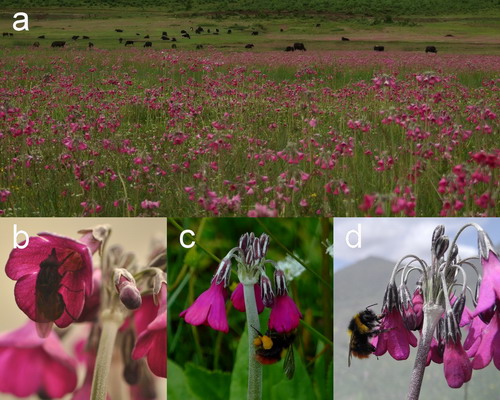Heterostyly is a genetically controlled floral polymorphism characterized by reciprocal placement of stigmas and anthers between two (distyly) or three (tristyly) floral morphs of a species (reciprocal herkogamy). Individual plants of distylous species produce flowers with either long styles and short stamens (L-styled) or short styles and long stamens (S-styled). Primula L. has been studied as a model for heterostyly, but pollination biology has been investigated thoroughly in only a few species. Primula secundiflora, a distylous perennial herb, is strongly self- and intra-morph incompatible.
Prof. LI Qingjun and his team of Xishuangbanna Tropical Botanical Garden (XTBG) have focused on the pollination biology of primrose in Hengduan Mountains for a few years. Their previous study showed that bumblebee nectar robbers only pollinated S-styled flowers. However, the natural seed production of thrum morphs was not uniformly greater than or equal to that of L-styled morphs in sampled populations. In a recent study, they hypothesized that there were other pollinators which made L-styled set more seeds.
The researchers conducted field experiments in six sites of Yunnan Province, with Primula secundiflora as the dominant species. They investigated pollinator assemblages, evaluated the pollination efficiency of pollinators, and compared female fecundity in six populations. They quantified natural fruit initiation, total seed production per plant, and number of seed per fruit to determine whether the morphs differ in their seed output. They also examined whether female reproductive potential differed between floral morphs and whether the seed production of P. secundiflora. They observed that the two most frequent floral visitors were the bumblebee Bombus richardsi and the syrphid fly Rhingia binotata.
After being visited by legitimate bumblebees, L-styled flowers and S-styled flowers set the same number of seeds. After pollen was added, L-styled flowers and S-styled flowers set the same number of seeds, indicating equivalent female reproductive potential. Between the two study years, no difference in the pollinator assemblages was found within populations.
They found that nectar-robbing B. richardsi bumblebees only pollinated S-styled flowers, whereas pollen-collecting R. binotata syrphid flies pollinated more L-styled flowers. Therefore, two kinds of asymmetrical disassortative pollination occur in P. secundiflora. The L-biased asymmetrical and S-biased asymmetrical disassortative pollination are complementary. The bumblebee nectar robbers and syrphid flies play an important role in sustaining the floral dimorphism of heterostyly in P. secundiflora.
The study entitled “Asymmetrical disassortative pollination in a distylous primrose: the complementaryroles of bumblebee nectar robbers and syrphid flies” has been published in Scientific Reports.

L-styled and S-styled flower of P. secundiflora

(a) Primula secundiflora-dominated alpine meadow; (b) Rhingia binotata collecting pollen;
(c) Bombus richardsi legitimately visiting a flower; (d) B. richardsi robbing a flower.
(Images by ZHU Xing-Fu)


